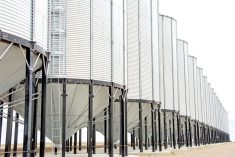CNS Canada — Canadian farmers grew a record amount of canola in 2017, despite weather concerns, according to updated production estimates on Wednesday from Statistics Canada.
The agency pegged production in 2017-18 at 21.3 million tonnes, up from the September estimate of 19.7 million and last year’s total of 19.6 million.
The rise in production was reflected on the charts as ICE Futures Canada canola futures dropped $3-$4 per tonne shortly after the market opened.
“I am surprised it was that big,” said Ken Ball of PI Financial in Winnipeg.
Read Also

U.S. grains: Soy hits four-month high on hopes for China trade deal
U.S. soybean futures jumped to their highest level in more than four months on Monday on hopes that China will resume buying American supplies after President Donald Trump said the countries were set to reach a trade deal during his trip to Asia this week.
Another analyst said the result indicates the warm, dry conditions felt in Saskatchewan and Alberta this summer did not negatively impact yields as many feared.
“It looks like the (stocks) situation won’t be as tight as earlier anticipated,” said Jerry Klassen, manager of Canadian operations with Swiss-based GAP S.A. Grains and Products in Winnipeg.
Mike Jubinville of ProFarmer Canada said the report is bearish in tone but its impact could fade quickly.
“I don’t see this as the be-all and end-all for the remainder of the year because the market can absorb a 21 million-tonne crop,” he said.
Canola tends to dip lower after U.S. Thanksgiving anyway, he added.
Going forward, most expect the market to again be driven by the competing influences of vegetable oil and the Canadian dollar.
Statistics Canada’s projection for wheat supplies also exceeded trade guesses. The agency pegged all-wheat supplies at nearly 30 million tonnes, surpassing analysts’ estimates of 27 million to 29.5 million tonnes. Last year, farmers produced 31.7 million tonnes of wheat in the country.
Ball said he had tempered his expectations for the Canadian wheat crop after the dryness problems in the western Prairies. He also pointed out that much of the crop will be on the low protein side.
At the same time, he said, some of his clients were reporting record wheat crops.
“It puts North American wheat in a neutral situation, otherwise we would be tight,” he said.
Another surprise in the report, Klassen said, was the barley estimate, at 7.9 million tonnes, compared to 8.8 million in 2016-17.
“It is slightly above expectations, which will temper the steam on the barley market,” he said.
Around half of this year’s barley crop is malt quality, which will put pressure on the feed, he said.
“Feed (prices) may have to get higher than malt to sell,” he said.
— Dave Sims writes for Commodity News Service Canada, a Glacier FarmMedia company specializing in grain and commodity market reporting. Follow CNS Canada at @CNSCanada on Twitter.
Table: A quick summary of Statistics Canada’s Dec. 6 crop production estimates for 2017-18. September estimates and year-ago numbers are included for comparison. Production in millions of metric tonnes.
| Pre-report | December . | September | ||
| trade estimates, . | estimate, | estimate, | ||
| 2017-18 | 2017-18 | 2017-18 | 2016-17 | |
| Durum wheat. . | 4.200 – 5.100 | 4.962 | 4.299 | 7.762 |
| All wheat | 27.000 – 29.500 | 29.984 | 27.130 | 31.729 |
| Oats | 3.300 – 4.000 | 3.724 | 3.802 | 3.195 |
| Barley | 7.200 – 7.900 | 7.891 | 7.306 | 8.784 |
| Flaxseed | 0.500 – 0.580 | 0.548 | 0.501 | 0.588 |
| Canola | 19.700 – 21.200 | 21.313 | 19.708 | 19.600 |
| Peas | 3.700 – 4.200 | 4.112 | 3.862 | 4.836 |
| Lentils | 2.500 – 3.100 | 2.558 | 2.439 | 3.248 |












